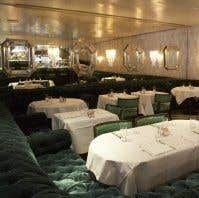This article was also published in the Financial Times.
A recent conversation with show-business writer Baz Bamigboye brought back memories of when he had been a regular customer in my former restaurant 25 years ago.
After I had recalled the phrase 'tbl', then used by many to refer to a 'two-bottle lunch', a phenomenon that has long since evaporated, he commented that he rarely conducts his interviews over lunch these days. 'When I need to meet someone I invariably arrange to meet them for breakfast in a restaurant', he added, 'because it saves so much time.'
At 9 am the following week I was sitting opposite Giacomo Maccioni, the General Manager of Cecconi's restaurant in Mayfair, over a plate of French toast, a bowl of granola with yoghurt, honey and mixed berries and two pots of English breakfast tea.
Maccioni had responded to my original question, that there must be a significant difference managing a restaurant that opens at 7 am and serves 170/180 breakfasts during a busy morning and managing one that opens only at midday, by saying 'Absolutely'. I was about to learn how Maccioni's professional career has mirrored our changing eating habits as increasing numbers now use breakfast in a restaurant as their first meeting of the day.
Born on the west coast of Sardinia, where he says his mother is still a great cook and he and his seven siblings each have small vineyards bequeathed to them by their late father, Maccioni began as a waiter at Cecconi's twenty years ago. Among his duties then were dry cleaning the lace curtains which used to cover the windows and maintaining the stock of spare jackets and ties without which no customer was allowed in. Enzo Cecconi, the original owner, waived this dress code once, for the boxer Frank Bruno, because no jacket was big enough. He even turned away the actor Mel Gibson, who refused to co-operate. In those days, Cecconi's, like so many other restaurants at the time, opened only for lunch and dinner.
When restaurateur Nick Jones (of Soho House etc) took it over in 2005, the decision was taken to open for breakfast but for the first few months business was hardly worth it. 'We were getting to work at 4 am but serving only 20 customers all morning. It was very disheartening', Maccioni explained.
An executive review revealed three different reasons for this initial lack of success. The first, Maccioni explained, was personal. 'I'm Italian so I am not in the habit of eating breakfast. But I realised that if I wanted this part of our business to be successful then I would have to give it every inch of my effort.'
The second was the layout of the menu, which was immediately redesigned to make it clearer and simpler, easier for any customer to read and choose from while talking business. It's one single sheet, with the drinks at the top and the 20-odd breakfast dishes, including scrambled eggs with generously sliced black truffles on top for only £10, listed underneath.
The final factor was a complete reorganisation of the kitchen and waiting staff to ensure that the breakfast service was as professional as at lunch and dinner. This involved a new rota for the cooks who start at 6 am and work through to 4 pm (fortunately they can park their scooters under the restaurant); a reorganisation of the timing of deliveries to ensure that they arrive long before the first customers; and a careful grouping of the waiting staff to serve his regular breakfast customers. 'What I quickly realised is that at breakfast customers not only tend to order their favourite things to eat and drink but they also like to be served by the same faces', Maccioni added.
The staffing levels are the same as for lunch or dinner, although there is one extra person on the espresso machine. And at 6.45 am every morning the waiters hold a brief meeting with the cooks, as they do 15 minutes before the start of the lunch and dinner services, to run through the list of reservations and any customer's special requests.
To ensure that they can meet many of their customers' expectations of a breakfast meeting's taking no more than 30 minutes, Maccioni introduced something he learnt from his former boss. 'When customers used to come in for an aperitif in the evening we used to offer them a little finger sandwich to nibble on. Now we offer every customer the first glass of freshly squeezed orange or grapefruit juice with our compliments. It gets the whole service moving', he explained, 'and then our aim is to get the coffee on the table in two to three minutes and our full English breakfast, the most complicated dish of all with sausages, bacon, eggs and roast tomatoes, served in no more than six or seven.'
The implications of such a busy breakfast service last long after the last customer has left at around 10 am, in Maccioni's view. Added to the fact that the restaurant already has a few thousand pounds in the bank and has fulfilled a useful role for its customers, the staff have been energised for an even busier lunch service.
Breakfast at Cecconi's appeals to many who work in the hedge fund and other professional offices nearby, who also have the choice of breakfast at The Wolseley only a short walk away. But Cecconi's proximity to Bond Street also attracts many women who work in the fashion industry, and, as a stylish Italian, Maccioni fully appreciates their custom. 'It's a great feeling to walk round the restaurant at 830 am and see four or five beautifully dressed women sitting at the same table having breakfast. It's an amazing sight. I love it.'
Cecconi's, www.cecconis.co.uk

